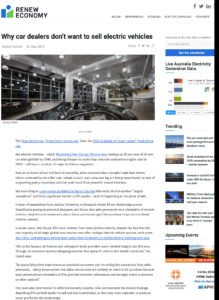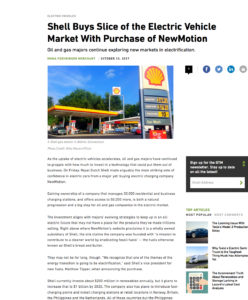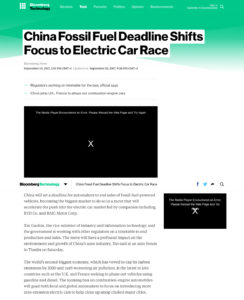Point-of-sale resistance to electric vehicles 22/06/18 • bit.ly/2Bmr3Sd
 Researchers from Aarhus University in Denmark visited 82 car dealerships across Scandinavia posing as potential shoppers.
Researchers from Aarhus University in Denmark visited 82 car dealerships across Scandinavia posing as potential shoppers.
 Researchers from Aarhus University in Denmark visited 82 car dealerships across Scandinavia posing as potential shoppers.
Researchers from Aarhus University in Denmark visited 82 car dealerships across Scandinavia posing as potential shoppers.
 Shell has made a vote of confidence in electric cars by buying electric charging company NewMotion, a company that manages 30,000 residential and business charging stations, and offers access to 50,000 more.
Shell has made a vote of confidence in electric cars by buying electric charging company NewMotion, a company that manages 30,000 residential and business charging stations, and offers access to 50,000 more.
 China will put an end to the sale of fossil-fuel-powered vehicles – gasoline and diesel – becoming the biggest market to do so in a move that will accelerate the push into the electric car market led by companies including the Chinese BYD Co. and BAIC Motor Corp.
China will put an end to the sale of fossil-fuel-powered vehicles – gasoline and diesel – becoming the biggest market to do so in a move that will accelerate the push into the electric car market led by companies including the Chinese BYD Co. and BAIC Motor Corp.
 Solar power is now cheaper than coal in some parts of the world. In less than a decade it could be the lowest-cost option almost everywhere.
Solar power is now cheaper than coal in some parts of the world. In less than a decade it could be the lowest-cost option almost everywhere.
![]() According to BP, electric vehicles are not likely to be a game changer for the growth of oil demand over the next 20 years where the increasing prosperity in emerging Asia is likely to swamp the impact of even a very rapid increase in electric cars. In fact, there may well be more cost effective methods of reducing CO2 emissions over this period, for example greater improvements in vehicle efficiency, a switch away from coal in the power sector, or increased investment in Carbon Capture and Storage. But these considerations should not detract from the many potential benefits that electric vehicles may bring.
According to BP, electric vehicles are not likely to be a game changer for the growth of oil demand over the next 20 years where the increasing prosperity in emerging Asia is likely to swamp the impact of even a very rapid increase in electric cars. In fact, there may well be more cost effective methods of reducing CO2 emissions over this period, for example greater improvements in vehicle efficiency, a switch away from coal in the power sector, or increased investment in Carbon Capture and Storage. But these considerations should not detract from the many potential benefits that electric vehicles may bring.
![]() OEF REVIEW:The first European fuel cell of megawatt size is now operating in Germany. Contrary to conventional power plants, this energy solution delivers heat and electricity virtually absent of pollutants. It will provide clean energy for the production processes of materials specialist FRIATEC. It has a capacity of 1.4 megawatts.In terms of technology and environmental protection, fuel cells represent a promising alternative to conventional combined heat and power plants. They generate power in a non-combustion process which is virtually absent of pollutants. By using this fuel cell, FRIATEC will be able to reduce its CO2 emissions by approximately 3,000 tons per year. Karsten Wildberger, a member of the E.ON SE Board of Directors, adds: “Fuel cells are one of the key technologies for the clean energy world of tomorrow.”
OEF REVIEW:The first European fuel cell of megawatt size is now operating in Germany. Contrary to conventional power plants, this energy solution delivers heat and electricity virtually absent of pollutants. It will provide clean energy for the production processes of materials specialist FRIATEC. It has a capacity of 1.4 megawatts.In terms of technology and environmental protection, fuel cells represent a promising alternative to conventional combined heat and power plants. They generate power in a non-combustion process which is virtually absent of pollutants. By using this fuel cell, FRIATEC will be able to reduce its CO2 emissions by approximately 3,000 tons per year. Karsten Wildberger, a member of the E.ON SE Board of Directors, adds: “Fuel cells are one of the key technologies for the clean energy world of tomorrow.”
![]() OEF REVIEW:The first wave-produced electricity in the US goes online in Hawaii. The ocean packs enough power to meet a quarter of America’s energy needs and reduce the nation’s reliance on oil, gas and coal. But wave energy technology lags behind wind and solar power, with important technical hurdles still to be overcome. Both the solar and wind industries received substantial government investment and tax credits that helped them become energy sources cheap enough to compete with fossil fuels. Wave energy test sites run by other researchers are being planned in Oregon and California. One of those projects, Cal Wave, run by California Polytechnic State University, hopes to provide utility-scale power to Vandenberg Air Force Base. But while the U.S. government and military have put about $334 million into marine energy research over the last decade, Britain and the rest of Europe have invested more than $1 billion, according to the Marine Energy Council.
OEF REVIEW:The first wave-produced electricity in the US goes online in Hawaii. The ocean packs enough power to meet a quarter of America’s energy needs and reduce the nation’s reliance on oil, gas and coal. But wave energy technology lags behind wind and solar power, with important technical hurdles still to be overcome. Both the solar and wind industries received substantial government investment and tax credits that helped them become energy sources cheap enough to compete with fossil fuels. Wave energy test sites run by other researchers are being planned in Oregon and California. One of those projects, Cal Wave, run by California Polytechnic State University, hopes to provide utility-scale power to Vandenberg Air Force Base. But while the U.S. government and military have put about $334 million into marine energy research over the last decade, Britain and the rest of Europe have invested more than $1 billion, according to the Marine Energy Council.
![]() OEF REVIEW:On March 7, Kokam announced that it had deployed two battery energy storage systems powered by nickel manganese cobalt oxide in South Korea. The company said that the 24-MW / 9-MWh system is the largest capacity Lithium NMC ESS used for frequency regulation in the world. Kokam said that its batteries provide ultra high power technology, which is designed for high-power energy storage applications, such as frequency regulation, wind or large solar power system ramp rate control, Uninterrupted Power Supply (UPS) and voltage support.
OEF REVIEW:On March 7, Kokam announced that it had deployed two battery energy storage systems powered by nickel manganese cobalt oxide in South Korea. The company said that the 24-MW / 9-MWh system is the largest capacity Lithium NMC ESS used for frequency regulation in the world. Kokam said that its batteries provide ultra high power technology, which is designed for high-power energy storage applications, such as frequency regulation, wind or large solar power system ramp rate control, Uninterrupted Power Supply (UPS) and voltage support.
Crescent Dunes Solar Energy, a 110 megawatt (MW) concentrating solar power (CSP) electricity plant, began full operation in February. Crescent Dunes uses an energy storage system that developers expect will be able to store enough thermal energy to generate electricity for up to 10 hours after sunset or on cloudy days when direct sunlight is unavailable. Unlike most other CSP plants that use synthetic oil as the intermediary fluid, Crescent Dunes uses molten salt, which has more advantageous thermal properties.
![]() OEF REVIEW:According to latest figures from the International Hydropower Association (IHA), the 1,036 GW of hydropower capacity generated over 16 percent of global electricity production in 2014. Looking to the year ahead, IHA identified several trends driving hydropower build-out. Prominent on the list is hydropower’s ability to function as a grid management asset: delivering base- and peak-load energy, frequency response and black-start capabilities. These solutions are recognized as critical to facilitate a successful transition to renewable energy. A second trend fostering steady investment is modernization, uprating, and conversion of existing plants in efforts to secure more efficient and sustainable operations. A third driver motivating fresh momentum for hydropower stems from ancillary hydropower functions that can assist nations in adapting to climate change: providing freshwater for irrigation, drought management and flood protection solutions.
OEF REVIEW:According to latest figures from the International Hydropower Association (IHA), the 1,036 GW of hydropower capacity generated over 16 percent of global electricity production in 2014. Looking to the year ahead, IHA identified several trends driving hydropower build-out. Prominent on the list is hydropower’s ability to function as a grid management asset: delivering base- and peak-load energy, frequency response and black-start capabilities. These solutions are recognized as critical to facilitate a successful transition to renewable energy. A second trend fostering steady investment is modernization, uprating, and conversion of existing plants in efforts to secure more efficient and sustainable operations. A third driver motivating fresh momentum for hydropower stems from ancillary hydropower functions that can assist nations in adapting to climate change: providing freshwater for irrigation, drought management and flood protection solutions.